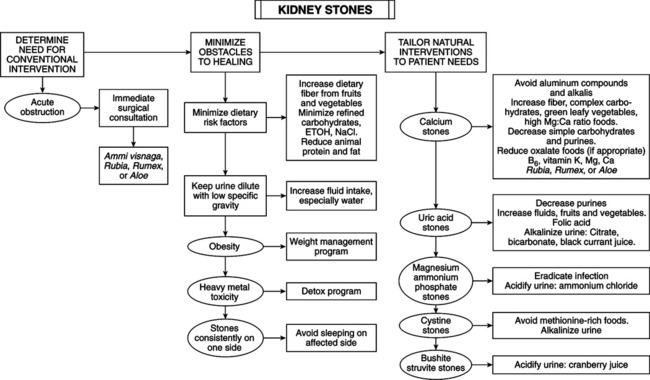• In the past, stone formation was almost exclusively in the bladder; today most stones form in upper urinary tract. Ten percent of all men have kidney stone during their lifetime. Annual incidence is 0.1%-6.0% of the general population. Incidence is steadily increasing, paralleling rise in other diseases linked to a Western diet (e.g., ischemic heart disease, cholelithiasis, hypertension, diabetes). • In the western hemisphere, kidney stones usually are com-posed of calcium salts (75%-85%), uric acid (5%-8%), or struvite (10%-15%). • Mutations in genes can lead to hypercalciuria, excess urinary excretion of oxalate, cystine, and uric acid. • Incidence varies geographically, reflecting environmental factors, diet, and components of drinking water. • Men are affected more than women. Most patients are older than 30 years. • Human urine is supersaturated with calcium oxalate, uric acid, and phosphates. They remain in solution because of pH control and secretion of inhibitors of crystal growth. • Primary and secondary metabolic diseases can cause kidney stones; they must be ruled out early in the clinical process (e.g., hyperparathyroidism, cystinuria, vitamin D excess, milk-alkali syndrome, destructive bone disease, primary oxaluria, Cushing’s syndrome, sarcoidosis. Conditions favoring stone formation include the following: • Factors increasing concentration of stone crystalloids: reduced urine volume (dehydration) and increased excretion of stone constituents. • Factors favoring stone formation at normal urinary concentrations: urinary stasis, pH changes, foreign bodies, reduction of normal substances that solubilize stone constituents. Causes of Excessive Excretion of Relatively Insoluble Urinary Constituents PTH, Parathyroid hormone; cAMP, cyclic adenosine monophosphate. Physical Changes in the Urine and Kidney
Kidney Stones
GENERAL CONSIDERATIONS

DIAGNOSTIC CONSIDERATIONS
Constituent
Cause of Excess Secretion
Laboratory Findings
Calcium
(>250 mg/day excreted)
Absorptive hypercalciuria
Low serum PO4
30%-40% of all stone formers
Renal hypercalciuria (renal tubular acidosis)
High serum PTH
High urinary cAMP
Primary hyperparathyroidism
High serum calcium
High 1,25(OH)2D3
Hyperthyroidism
High vitamin D intake
High serum calcium
Excess intake of milk and alkali
Aluminum salt intake
Low serum phosphate
High 1,25(OH)2D3
Destructive bone disease
Sarcoidosis
Prolonged immobility
Oxalate
Familial oxaluria
Rare
Ileal disease, resection, or bypass
Steatorrhea
High oxalate intake
Ethylene glycol poisoning
Vitamin C excess (extremely unlikely)
Vitamin B6 deficiency or abnormal oxalate metabolism
Methoxyflurane anesthesia
Uric acid
(>750 mg/day excreted)
Gout
Idiopathic hyperuricosuria
Excess purine intake
Anticancer drugs
Rapid cell destruction
Myeloproliferative disease
Cysteine
Hereditary cystinuria
Condition
Possible Cause
Increased concentration
Dehydration
Stasis
Obstruction
Foreign body concretions
Urinary pH
Low—uric acid, cystine
High—calcium oxalate and PO4
Infection
Proteus—struvite
Uricosuria
Crystals of uric acid initiate precipitation of calcium oxalate from solution
Nuclei for stone formation
Cells bacteria, blood, etc. initiate precipitation
Sponge kidney
Horseshoe kidney
Deformities of kidney
Caliceal obstruction or defect
Stay updated, free articles. Join our Telegram channel

Full access? Get Clinical Tree


